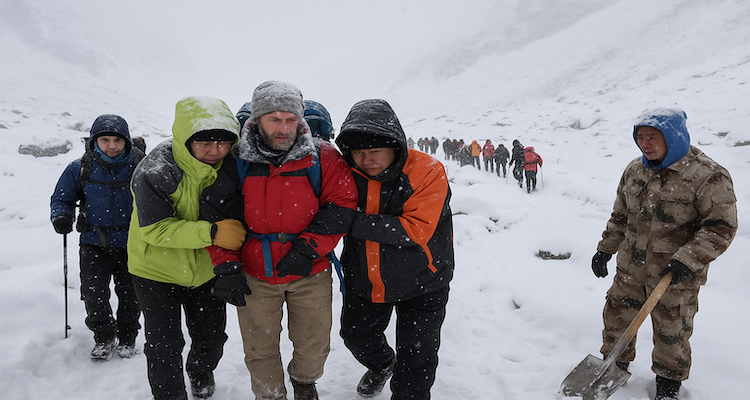Blizzard Strands Hundreds Near Mount Everest: Rescuers Lead Trekkers to Safety
Hundreds of trekkers stranded near Mount Everest’s eastern face in Tibet were rescued after a severe Himalayan blizzard, with authorities racing against time to ensure everyone’s safety.
A Sudden Storm Turns a Scenic Trek Into a Fight for Survival
What began as a dream adventure near the eastern face of Mount Everest quickly turned into a harrowing ordeal for hundreds of trekkers this weekend. Caught off guard by an intense Himalayan blizzard, the travelers-many visiting the remote Karma Valley during China’s National Day holidays found themselves stranded in freezing conditions before rescuers managed to guide them to safety.
According to China’s state broadcaster CCTV, more than 350 trekkers have safely reached the small township of Qudang, while contact has been made with over 200 others still making their way down under rescue supervision.
An Unexpected Weather Fury in the Himalayas
The Karma Valley, which leads to the stunning Kangshung face of Mount Everest, was hit by heavy snowfall and torrential rain beginning Friday evening. The storm intensified overnight, blanketing the region situated at an altitude of about 4,200 meters (13,800 feet) with thick snow that made trails nearly impassable.
Rescue operations were launched immediately as hundreds of trekkers and local guides were reported trapped. By Sunday, villagers and emergency teams had cleared critical mountain paths and established communication with those still en route to safety.
Survivors Describe a Night of Fear and Cold
For many, survival came down to sheer resilience. Chen Geshuang, a member of an 18-person trekking team, described the ordeal to Reuters:
“It was unbelievably wet and cold. The guide warned us about hypothermia it felt like the mountain was closing in on us.”
Chen and her group eventually reached Qudang, exhausted but alive. She recalled the emotional moment they were welcomed by villagers offering warm tea and food after a night spent battling snow, thunder, and lightning.
“I’ve never seen weather like this in October. Even our guide said it was unprecedented. It all happened so suddenly,” Chen added.
Rescue Efforts Mobilized Across Tibet
Local authorities deployed hundreds of villagers and emergency personnel to clear roads and assist stranded hikers. Earlier reports from state-backed Jimu News estimated that nearly 1,000 people had been trapped across the region before rescue teams gained control of the situation.
Officials confirmed that the remaining trekkers are being brought down in stages with coordinated assistance from local rescue units. Meanwhile, heavy machinery has been dispatched to remove snow-blocked routes and restore access to isolated areas.
Tourism Disrupted at the Roof of the World
The storm’s impact rippled across Tibet’s tourism sector. Authorities in Tingri County home to the popular north face of Mount Everest announced a temporary suspension of ticket sales and visitor entry to the Everest Scenic Area starting late Saturday.
October typically marks the peak trekking season, with clear skies and stable weather following the end of the Indian monsoon. However, this year’s erratic weather patterns disrupted the expected calm, leaving many questioning the growing volatility of Himalayan climates.
While CCTV did not confirm whether guides and porters have been fully accounted for, no casualties have been reported so far in the Tibetan region.
Deadly Rains Ravage Neighboring Nepal
The same storm system wreaked havoc further south in Nepal, where torrential rain triggered landslides and flash floods. At least 47 people have died since Friday, with dozens missing.
The hardest-hit area, Ilam district near the Indian border, saw 35 fatalities from separate landslides. Elsewhere, nine individuals were swept away by floodwaters, and three others were killed by lightning strikes. Roads and bridges have been washed away, severely disrupting transportation and relief operations.
Climate Extremes Rising in the Himalayas
Meteorologists have long warned that climate change is amplifying the frequency and intensity of extreme weather in high-altitude regions like the Himalayas. This latest blizzard underscores how fragile mountain ecosystems and the people who depend on them have become in the face of global warming.
Experts suggest that warmer air holds more moisture, increasing the risk of sudden snowstorms and heavy rainfall in traditionally dry months like October. For trekkers and local communities, adapting to these unpredictable conditions is becoming a new reality.
A Narrow Escape, but a Lingering Lesson
As trekkers recover in Qudang and nearby villages, many are reflecting on how quickly a peaceful expedition turned perilous. While no fatalities were reported on the Tibetan side, the event has prompted renewed calls for better early-warning systems, stricter weather advisories, and improved rescue coordination in remote Himalayan regions.
For now, the mountain trails remain quiet-echoing the sobering reminder that even the world’s most breathtaking landscapes can turn treacherous in an instant.
(Disclaimer: This article is based on verified information from Chinese state media, Reuters, and official local reports. It does not include speculation or unconfirmed data.)
ALSO READ: Can Mushrooms Save the World… Or Kill It?










